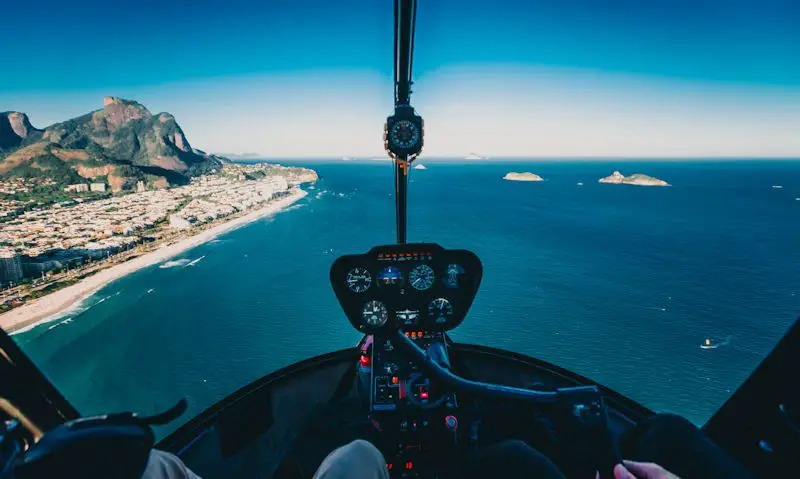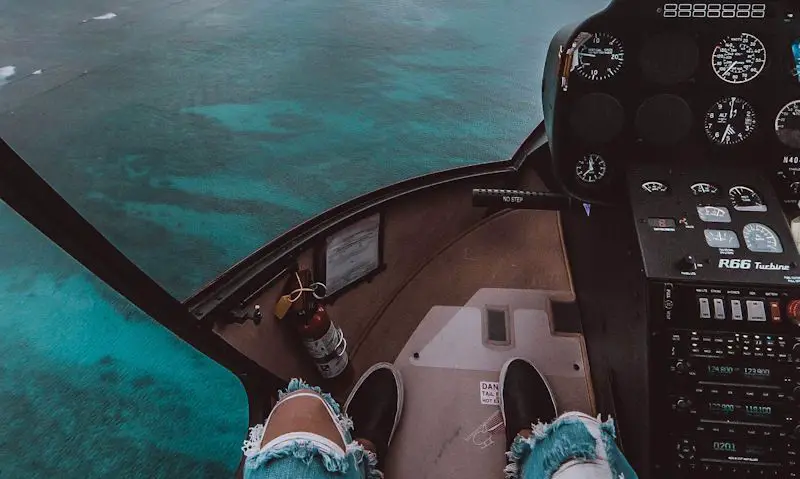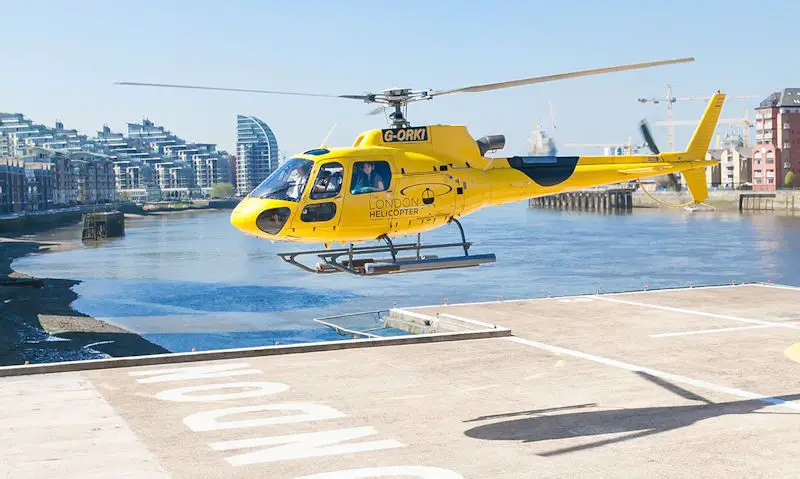What to expect on a helicopter ride
If you know what to expect on a helicopter ride from the moment you arrive, to when the helicopter lands back at base, you should feel more settled.
Expect a photo ID to be checked before proceeding to a safety briefing. All while camera or phones will need to be tethered, well hazardous items will need to be removed. Helicopter ride itself can be thrilling with tight manoeuvring, with sunglasses needed if its sunny or layers if its windy.
- Photo I.D. check
- What you can or cannot wear
- Life jacket if flying over water
- Compulsory safety briefing
- You will have to be weighed
- Seating arrangements
- Delay or cancellation
- Manoeuvres can be thrilling
- Sunshine or windy in cabin
- Too tall or overweight will suffer
- Need to wear a headset
- Anxiety for all passengers
- Summary
Arriving at the point of departure could be a city heliport, regional airfield or helicopter flights could operate out of a major airport location.
Once in the building, you'll be greeted or staff will approach after a moment. No time to waste as you'll photo ID will need to be checked and all passengers must be weighed.
Soon after you'll be notified about your seating arrangement inside the helicopter.
If all is fine, and it will be, its then time to move onto the short safety briefing.
That will involve a talk about what to do in case of an emergency and how to use the life-jacket if the helicopter ride flies over water.
With basic instructions on how to put on or unbuckle your seatbelt, where the first aid kit is, and similarly - the location of the fire extinguisher.
Once settled in your seat, headphones must be put on so you can communicate with the pilot and other passengers in the private or shared helicopter ride.
In flight expect the helicopter to manoeuvre in a way that could make your stomach turn, not quite like a rollercoaster - more like when you go over a bump in the road.
Sun or wind can trouble you in mid-flight so its imperative you do bring sunglasses just in case, all while wear layers if its a cold day, as even a warm gust can get chilly.
Its possible to feel scared on a helicopter ride, but its common for most passengers with the feeling to soon fade away soon after takeoff.
Photo I.D. check
Anyone who takes a helicopter wherever you may be in the world, will likely need to bring along photo I.D. for the purpose of identification.
Likely locations where photo identification is needed; will be the UK, Canada, Australia, New Zealand and much of Europe.
If abroad then absolutely bring your passport along as anything less will not qualify for foreign nationals.
Photo ID is needed to check your name and details against the information that was used when booking your helicopter ride online or over the phone.
So therefore its imperative the payer, or credit card hold brings I.D. that matches the details the helicopter ride operator has in hand.
The person who booked and paid for the helicopter ride will need to first get things checked over, before his or her companions have there photo ID checked.
Passports will then need to be tucked away in a secure - possibly zipped up - pocket for the duration of the helicopter flight.
What you can or cannot wear
Once all ID's have been checked over and all passengers are clear, it may be the staff who are overseeing your customer care will not be happy with what you're wearing.
That is not a criticism or judgment on your fashion sense; in helicopter ride terms what you wear could cause issues for you, passengers, or worse still, the helicopter mechanics.
With that in mind, first you'll need to remove necklaces and bracelets; including hats or any headwear for that matter.
Other jewellery that will obstruct the wearing of noise canceling headphones will be dangling earrings, so will need to be removed.
People who wear prescription glasses will not not be asked to remove them; on your part you just need to make sure they're secure.
Nothing can be tied around you in regards to scarves, although if its a cold day you can wear gloves.
Shoes will not be judged but its vital they will not cause you issues well getting in or out of the helicopter - such as high heels or slip-on sandals.
Life jacket if flying over water
If you're taking a helicopter ride that involves spending time flying over lakes, rivers or the ocean; a life jacket must be warn by passengers for the duration of the flight.
In your safety briefing - which I'll get into on the next topic - you will be shown how to put on a standard floatable life jacket vest that straps around the waist, fitted like a vest, and what to do if its the inflatable type.
In Hawaii passengers will mostly likely be wearing a life jacket in most flights as all but a handful will involve water at some point.
Similarly, in New York a life jacket will be worn as New York helicopter tours tend to involve flying over the Hudson River, and not actually the city itself.
Another type of life jacket helicopter passengers will need to get familiar with is the Self-Inflateable PFD, which is worn strapped around your waist.
In case of an emergency over water, passengers will already be taught to pull the rip-cord as to inflate the life jacket - which can then be placed over the head.
If exiting the helicopter in the water the life jacket will bring you to the surface of the water; all while keeping you afloat until rescuers arrives.
Compulsory safety briefing
No need to be afraid with the thought of a safety briefing; millions of fellow passengers receive the quick talk or demonstration before they fly.
Safety briefings must be carried out before you fly as a matter of health and safety.
It may vary depending what helicopter ride operator you book with or where you are in the would, but it should look something like this:
- How to enter and exit the helicopter via the step on the skid, or landing gear
- Where to sit after your weigh-in
- How to buckle yourself in or remove seatbelt
- Know how to use a sick bag
- Location of first aid kit or fire extinguisher
- How to use an inflatable life jacket
- Procedure in case of an emergency
Often much of the safety briefing will be demonstrated in a video where all passengers have to sit through and watch.
More often than not it will be the staff who will talk through the details; which is true for must helicopter ride companies.
After your weigh-in on the scale, all data will be calculated so the staff can do what is known as in helicopter terms - weight and balances.
Meaning you will sit according to how heavy or light you are; this helps balance the helicopter so its not too heavy or light on one side.
Then, to put on your seatbelt and undo it in case of an emergency you may be physically shown how to do it by the pilot themselves out on the helipad.
You will have to be weighed
Before the weight-in of all passengers you will need to go for, what is for most of us; an embarrassing weigh-in - like you would at the doctors.
Now don't be too worried here as you're not going to be called out in front of your fellow passengers with how heavy you are.
In fact you'll be called up one at a time so others will not be able to see the dial on the scale.
The person weighing you needs this information so the know where you can sit in the helicopter.
Weight and balances plays a vital role is distributing weight inside an aircraft; so without it the helicopter could drift over to the side, for example.
You cannot get out of being weighed if the operator requires it; refusing to them to take your weight will simply delay or worse, cancel your helicopter ride.
Seating arrangements
Now that the pilot or staff who operate within the heliport have taken your weight, they will then quickly make arrangements for your seating positions.
Priority will be placed on anyone who has paid for an upgrade to the seat next to the pilot; but if your weight or height can effect the balance of the helicopter, you could be bumped back to a middle seat.
If you really want to sit next to your friend or spouse; again its a not a guarantee but the company will do there best to keep you together.
Where you end up sitting inside the helicopter will effect your photography - that is if you plan to take pictures, and lots of them.
In which case you'd want to make special arrangements beforehand to alteast get sat on a window seat - if weight and balances allows for it.
If you feel being stuck in the middle seat in the back is the worse seat in the heli, that might not necessary be so, depending on the type helicopter model.
Clear viewing can still be maintained through the window providing you do have height.
Delay or cancellation
Its all while and good checking the weather to see if there's any risk your helicopter ride will be cancelled, but there is still a risk.
What a person who is not familiar with what type of weather effects air travel, will incorrectly deem it suitable or not - the reality is helicopters could be grounded.
Any risk to your helicopter ride being cancelled, the helicopter operator will get in touch with you before you head out to let you know its off.
However, you'd want to phone the operator themselves to get an update on whether the flight will go ahead.
If the operator do tell you all is OK, know that things can still be cancelled if the weather changes unexpectedly.
If the weather is perfect for a scenic helicopter sightseeing ride, then expect a delay to your flight if its a busy time of the year.
If the cancellation is not the fault of your own, the operator will refund you. If a cancellation is a fault of your own, you may not be entitled to a refund.
Manoeuvres can be thrilling
People who expect a calm or relaxing helicopter ride, all while enjoying the wonder passing by outside your window, should expect the unexpected.
Its like this, often the pilot will manoeuvre the helicopter in a sharp left or right; this can be felt by the passengers with a feeling that is exciting for most, but a little nerving for others.
The feeling is similar to that of a child-friendly rollercoast, or when you drive over a bump in the road in the car.
Likely effect of this is your stomach will sink, almost a gut wrenching feeling for many of us, but a feeling you will absolutely love, and will want more.
But other passengers will not feel the effect the same; so expect a passenger who will not be too thrilled.
The pilot will do there very best to keep things steady if its not a helicopter buzz flight or adrenalin theme ride you have signed up too.
But it can happen as the helicopter turns dramatically, causing the helicopter to tilt on a slight angle which is felt by the people inside.
Sunshine or windy in cabin
One major unexpected occurrence during the helicopter flight is the wind or sunshine effecting the comfort of your ride.
In the wind, especially if you're taking a doors off helicopter ride, you will be effected by the wind in two way...
One, wind will effect anyone with long hair so will absolutely need to be tied back, and two; wind can lead to chill, so wear layers if you know its going to get cold.
Then there's the strong sunshine that will effect all passengers at some point as the helicopter's route will lead to the sun shining through in all directions.
Take your cue from the pilot wearing sunglasses; if its something the pilot has to wear, then passengers will need too also.
So its recommended all passengers - even if you don't like wearing sunglasses - bring along a pair just in case.
What's good for wearing in the car should be replicated clothing for wearing in the air.
Too tall or overweight will suffer
If you feel you or know you are an overweight person, this could prevent you from flying as the most common weight limit is 17st., or 238 lb.
What this means is you will not be able to fly, so its imperative you double check before you book a ride to make sure you are far below the recommended limit.
Demonstrated weight limit example does not apply to all operators; it will depend on the company who will fly you, and the type helicopter model used.
If you do qualify to fly, even if you feel you are overweight still; known that seating can be a little too tight, and you will suffer for it.
Not only that the passengers sitting next to you may not be best pleased you're spilling over onto there already tight personal space.
If you would believe it, even tall people might suffer; being over 6.2 feet or more could cause trouble in regards to seating.
Then there's the head space allowed in a helicopter, whereas a tall person could suffer as there head bumps on the ceiling.
Need to wear a headset
No passenger will be allowed to get away by not wearing there own noise canceling headset, and for good reason.
Often the high pitch sound of the helicopter, especially if its an open door helicopter ride, can pierce the ear, causing discomfort.
More importantly, all passengers need to be in contact with the pilot at all times, so will be impossible if you're not wearing the headset to communicate.
It won't be possible to talk to fellow passengers or the pilot without a headset, as the head piece will cancel out your voice.
In wearing the headset comfortably you must not be wearing earrings; a small stud set will be fine, but anything more than a dangling earring will need to be removed.
With the headset covering both ears, the microphone that you talk through will be positioned near to your mouth.
If at any point it moves in an obstructing way or comes into contact with you face, you can move it back into place.
Anxiety for all passengers
If you're a seasoned helicopter ride passenger or its your first time taking a helicopter ride, know that feeling scared is very normal.
The good news is after a short while any anxiety will fade away has you try to take in all the sights through the windows.
If you feel you will be sick, know that some, not all; helicopter operators will provide a sick bag for all passengers - showing you how to use it during your safety briefing.
Anxiety will develop in the lead up to the helicopter flight but know that for most people it will soon fizzle away.
It won't once you're in the helicopter, but in a short few minutes after takeoff the nervousness will disappear.
That takes me on to other passengers, as it happens it might not just be you but other passengers could feel scared.
In rare cases, they could be loud or freak out, to which you'd want to ignore them as comforting could lead to more anxiety.
Summary
What to expect on a helicopter ride will begin on the ground; as soon has you have turned up at the heliport, you helicopter ride experience will begin.
Not before the staff check your order against there reservations with help of a photo ID; including a passport, or a driving license if you are local.
What you arrive wearing on the day should be sufficient enough to fly; though all loose items such as scarves or jewellery will need to be left behind.
No getting out of an important, yet compulsory briefing on safety; with instructions or a physical demonstration on using a seatbelt or how to use a life jacket, if flying over water.
Know that all passengers will have to be weighed for weight and balances.
Once in the chopper, up and away you go as the area beneath you gets smaller or disappears right away as the helicopter turns around or backs up.
While a thrilling, buzz like helicopter ride may not be on the itinerary...
Know that for unforeseen circumstances, there's a time where the helicopter will pull a move that could make your stomach turn - but its really fun to say the least.
With time spent at 1500ft to 2000ft while traveling approximately 120mph; the sun can be in your eyes or the wind or air in the helicopter can become chilly.
Depending on the country climate or time of the year, dress accordingly.
You will always want to bring a pair of sunglasses just in case, well making sure you're layered up if the air outside is cold on the ground, as it would be in the air.



